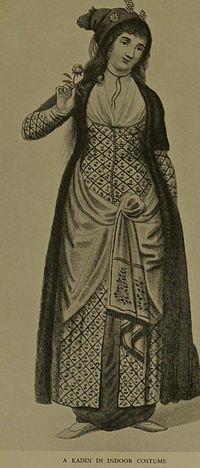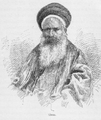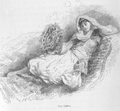- Ottoman clothing
-
Ottoman clothing is the style and design of clothing worn by the Ottoman Turks.
Contents
Ottoman period
While the Palace and its court displayed showy clothes, the common people were only concerned with covering themselves. The administrators occasionally brought about legal regulations on clothes (see sumptuary laws). These applications were first initiated during the period of Suleiman the Magnificent. In this period men wore outer items such as 'mintan', 'zıbın', 'şalvar' (trousers), 'kuşak', 'potur', 'entari' (a loose coat), 'kalpak', 'sarık' on the head; 'çarık', 'çizme', 'çedik', 'Yemeni' on the feet. The administrators and the wealthy wore caftans with fur lining and embroidery, whereas the middle class wore 'cübbe', 'hırka' and the poor wore collarless 'cepken' or 'yelek' (vest). Bashlyks were the most prominent accessories of social statues. While the people wore "külah's" covered with 'abani' or 'Yemeni', the cream of the society wore bashlyks such as 'yusufi, örfi, katibi, kavaze', etc. During the rule of Süleyman a bashlyk called 'perişani' was popular as the palace people valued bashlyks adorned with precious stones. 'Kavuk', however, was the most common type of bashlyk. For this reason, a related tradesmenship was formed in the XVII. century. Fur was a material of prestige in that period. The clothing of Muslims, Christians, Jewish communities, clergy, tradesmen state and military officials were strictly regulated during the reign of Suleiman the Magnificent. Political crises of the XVII. century were reflected as chaos in clothes. The excessively luxurious compulsion of consumption and show off in the "Period of Tulips" lasted till the XIX. century. The modernization attempts of Mahmut II in 1825 first had its effects in the state sector. While 'sarık' was replaced by 'fez', the people employed in Bab-ı Ali began to wear trousers, 'setre' and 'potin'.
During the 'Tanzimat' and 'Meşrutiyet' period in the XIX century, the common people still keeping to their traditional clothing styles presented a great contrast with the administrators and the wealthy wearing 'redingot', jacket, waistcoat, boyunbağı (tie), 'mintan', sharp-pointed and high-heeled shoes. Women's clothes of the Ottoman period were observed in the 'mansions' and Palace courts. 'Entari', 'kuşak', 'şalvar', 'başörtü', 'ferace' of the XIX century continued their existence without much change. In the XVI. century women wore two-layer long 'entari' and 'tül', velvet shawl on their heads. Their outdoor clothing consisted of 'ferace' and 'yeldirme'. The simplification in the XVII century was apparent in an inner 'entari' worn under short-sleeved, caftan-shaped outfit and the matching accessory was a belt.
Women's wear becoming more showy and extravagant brought about adorned hair buns and tailoring. Tailoring in its real sense began in this period. The sense of women's wear primarily began in large residential centers such as Istanbul and İzmir in the XIX century and as women gradually began to participate in the social life, along with the westernization movement. Pera became the center of fashion and the Paris fashion was followed by the tailors of Greek and Armenian origin. In the period of Abdul Hamid II the use of 'ferace' was replaced by 'çarşaf' of different styles. However, the rural sector continued its traditional style of clothing.
Republican period
The clothing styles prevailing until the mid XIX. century imposed by religious reasons entered a transformation phase of the Republican period. In this period the 'şapka' and the following 'kılık kıyafet' reform realized with the leadership of Mustafa Kemal Atatürk in Kastamonu in 1925 had a full impact in Istanbul. Women's 'çarşaf' and 'peçe' were replaced by coat, scarf and shawl. Men began to wear hats, jackets, shirts, waistcoats, ties, trousers and shoes. With the industrialization process of the 1960s women entered the work life and tailors were substituted by readymade clothes industry. The contemporary fashion concept, as it is in the whole world, is apparent in both social and economic dimensions in Turkey as well.
Modern use
The concept is conveyed with all its aspects in various educational institutions not only in the field of application but also from the point of design and employees required by the sector are trained. Designers that have been drawing attention with their universal works; Rıfat Özbek, Cemil İpekçi, Vural Gökçaylı, Yıldırım Mayruk, Sadık Kızılağaç, Hakan Elyaban, Bahar Korçan and many more creative personalities have been contributing original and modern works. As the developing Turkish economy owes a lot to textile exports, the general framework deserves a historical outlook on the concepts in question.
Gallery
Religious garb
Classical period
-
Turkish Zeybek (1878)
Decline
See also
References
- Feyzi, Muharrem. Eski Türk Kıyafetleri ve Güzel Giyim Tarzları.
- Koçu, Reşat Ekrem. Türk Giyim Kuşam ve Süslenme Sözlüğü. Ankara: Sümerbank, 1967.
- Küçükerman, Önder. Türk Giyim Sanayinin Tarihi Kaynakları. İstanbul: GSD Dış Ticaret AŞ, 1966.
- Sevin, Nurettin. Onüç Asırlık Türk Kıyafet Tarihine Bir Bakış. Ankara: T.C. Kültür Bakanlığı, 1990.
- Tuğlacı, Pars. Osmanlı Saray Kadınları / The Ottoman Palace Women. Istanbul: Cem Yayınevi,1985.
External links
Categories:- Ottoman clothing
- History of Asian clothing
Wikimedia Foundation. 2010.




















